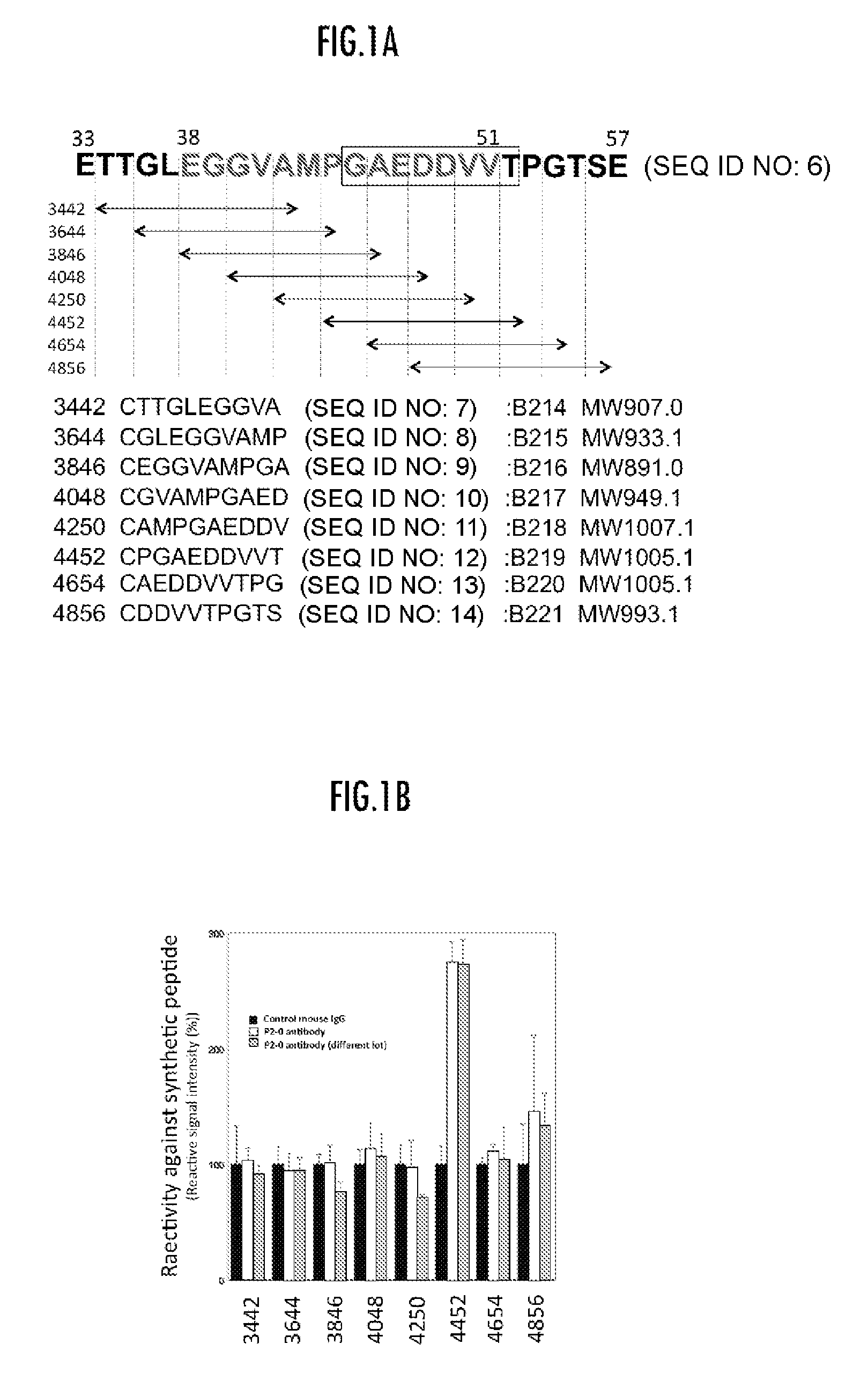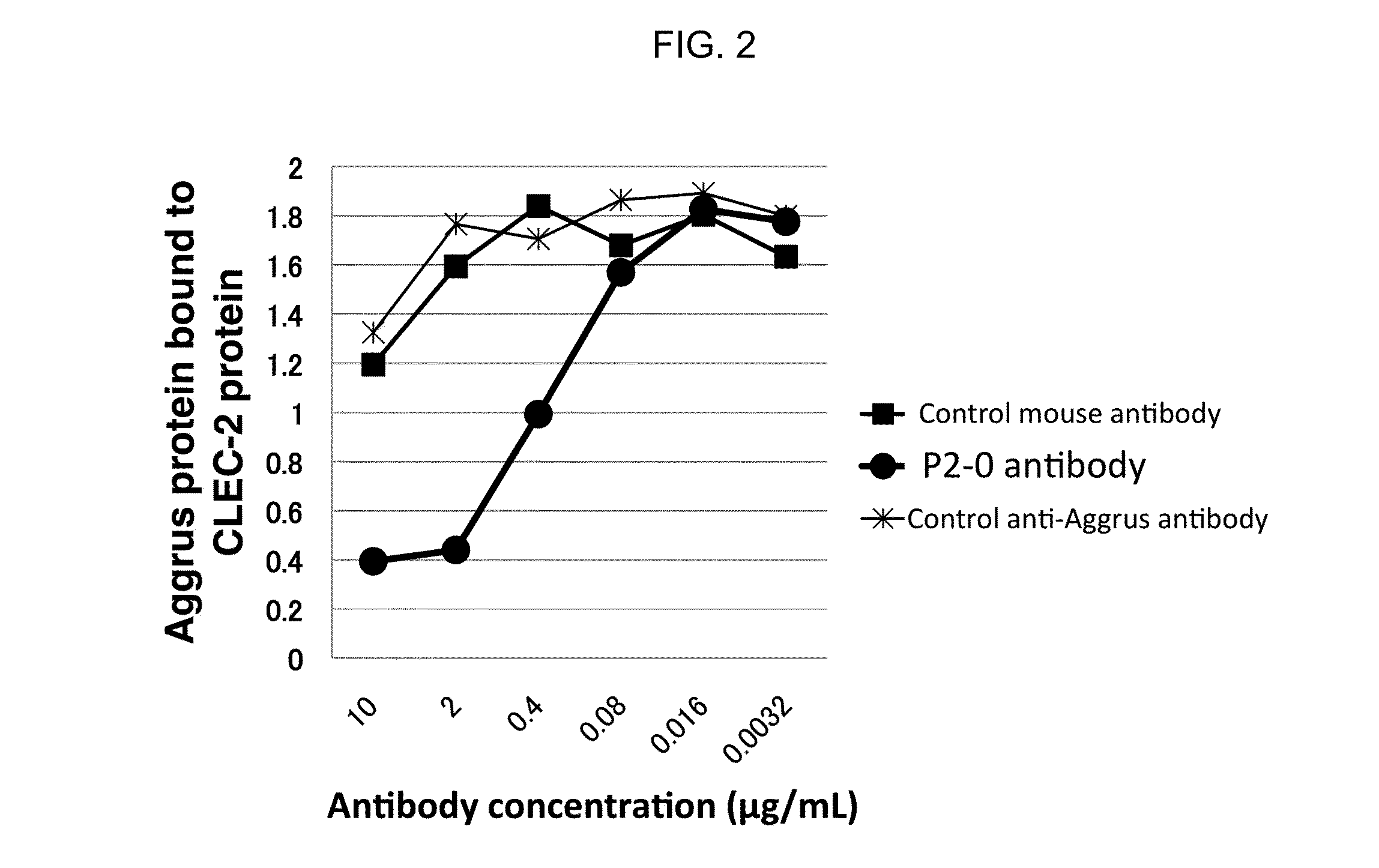Mouse anti-Aggrus monoclonal antibodies
a monoclonal antibody and mouse technology, applied in the field of mouse antiaggrus monoclonal antibodies, can solve the problems of poor clinical outcome, inability to precisely examine rat antibodies in universal use, and inability to precisely examine rat antibodies, and achieve different reactivity, inhibit aggrus-dependent pulmonary metastasis, and inhibit the effect of aggrus-clec-2 binding
- Summary
- Abstract
- Description
- Claims
- Application Information
AI Technical Summary
Benefits of technology
Problems solved by technology
Method used
Image
Examples
embodiment 1
[0059]Immunogen to Establish Hybridomas which Produce Mouse Anti-Human Aggrus mAbs
[0060]A human aggrus cDNA region encoding the TT679 antigen (14 a.a. located on 38-51 of Aggrus protein, Sequence ID 2: Glu Gly Gly Val Ala Met Pro Gly Ala Glu Asp Asp Val Val) was cloned and connected eight times repeatedly (TT679-repeat) on a pGEX-6P-3 vector (GE Healthcare, Buckinghamshire, UK). BL21 Escherichia Coli (Invitrogen, Carlsbad, Calif.) was transformed with these vectors, and GST-tagged recombinant proteins were purified using Glutathione Sepharose (GE Healthcare).
[0061]Sensitization
[0062]Six-week-old female BALB / c mice (bought from Charlesriver Laboratories Japan, Inc., bred according to common procedure) were immunized by neck subcutaneous injections of the immunogen obtained in above with Freund's complete adjuvant (Difco Laboratories, Detroit, Mich.). Every other week, intraperitoneal immunization was performed.
[0063]Establishment of Hybridomas
[0064]Spleen cells harvested according to...
embodiment 2
[0065]Analysis of Mouse Anti-Human Aggrus mAbs Verification by Western Blotting
[0066]Among anti-Aggrus mAb-producing hybridomas, one hybridoma which produces P2-0 mAb was deposited to National Institute of Technology and Evaluation-International Patent Organism Depositary on Feb. 18, 2011, and was assigned deposit ID of FERM BP-11446 (identical to deposit ID FERM P-22069). P2-0 mAb was confirmed to recognize human Aggrus by flow cytometry analysis and western blotting. Moreover, when western blotting was performed using prepared Aggrus mutants with deficient amino acid Sequence ID 2, P2-0 mAb could not recognize the same.
embodiment 3
[0067]Exploring of Epitope
[0068]As shown in FIG. 1, reactivity of P2-0 mAb to various peptides for chemical synthesis was examined by ELISA method. As a result, P2-0 mAb exhibited high reactivity to one peptide containing 44-52 amino acids sequence (Sequence ID 1).
PUM
| Property | Measurement | Unit |
|---|---|---|
| flow rate | aaaaa | aaaaa |
| dissociation constant | aaaaa | aaaaa |
| dissociation constant | aaaaa | aaaaa |
Abstract
Description
Claims
Application Information
 Login to View More
Login to View More - R&D Engineer
- R&D Manager
- IP Professional
- Industry Leading Data Capabilities
- Powerful AI technology
- Patent DNA Extraction
Browse by: Latest US Patents, China's latest patents, Technical Efficacy Thesaurus, Application Domain, Technology Topic, Popular Technical Reports.
© 2024 PatSnap. All rights reserved.Legal|Privacy policy|Modern Slavery Act Transparency Statement|Sitemap|About US| Contact US: help@patsnap.com










